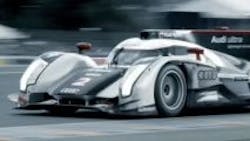Flywheels give Formula 1 cars some zip
Many years ago, engineers at the old Chrysler Corp. planned to develop a 500-hp entry for the LeMans 24-hour endurance race powered by a flywheel turbine powerplant. The idea never really got off the ground, but those individuals must have felt vindicated in June when a hybrid car fielded by Audi won the race while drawing power in-part from a composite flywheel.
The win at LeMans has put flywheel technology in the spotlight. And Audi isn't the only carmaker looking at flywheels. Reports are that Volvo is evaluating the technology as a way to boost fuel economy and get rid of the lag that characterizes turbocharged engines when the driver hits the gas.
Flywheel energy storage potential is proportional to the mass moment of inertia and the square of rotational speed. So modern flywheels in autos tend to spin light materials at high speeds to store energy, rather than use a lot of mass at lower rotational speed. Speed is limited by the strength-to-density ratio of the rotor material, so strong-but-light composite materials have gotten most of the attention.
One problem that has plagued high-performance flywheels in the past is that composites can delaminate or be subject to failures in the fiber/matrix material under the right conditions. When that happens, the flywheel can explode. The need to reliably contain high-energy-density flywheels was highlighted 17 years ago when an engineer in Germany was killed during a spin test of a composite flywheel.
Another potential problem concerns the rare-earth magnets frequently used to make the flywheel into a rotating-field generator. The specific strength of these magnets is typically much less than that of the composite flywheel. So the usual approach has been to locate them near the inner portion of the flywheel and thus allow them to spin at much lower tip speeds than the flywheel's outer diameter. But this reduces the power density of the generator.
The flywheel powering Audi's R18 e-tron quattro LeMans winner comes from Williams Hybrid Power in the UK. The device spins at 60k rpm at full speed, and Williams says it has an all-composite structure other than the shaft. But other details about its operation and make-up are hard to come by, though Williams does say it has a higher specific energy than ultracapacitors. This is noteworthy in that Toyota fielded a hybrid LeMans entry this year that went with ultracap storage rather than with a flywheel.
In the Audi hybrids, an electric traction motor sits on the front axle. When the driver brakes, the traction motor acts as a generator and feeds juice to the flywheel. When the driver accelerates, the flywheel routes electrical power back to the traction motor which powers the front wheels. This momentarily turns the car into a four-wheel-drive vehicle and gives it an extra burst of speed while accelerating.
Also, the only connection between the flywheel and the traction motor are power cables. There are are no mechanical linkages between the flywheel and the rest of the car's mechanics.
Finally, the flywheel system does more than just boost power during acceleration. Audi says it also enabled the car to do 12 laps on a single tank of fuel where competitors were only able to get 11 laps.
Williams Hybrid Power, http://www.williamshybridpower.com/technology/the_flywheel/#/intro
Audi e-tron racing, http://www.audi.com/com/brand/en/audi_sport/wec/audi_r18_tdi_audi.html#source=http://www.audi.com/com/brand/en/audi_sport/wec/audi_r18_tdi_audi.tab_2.html&container=tabAjax
